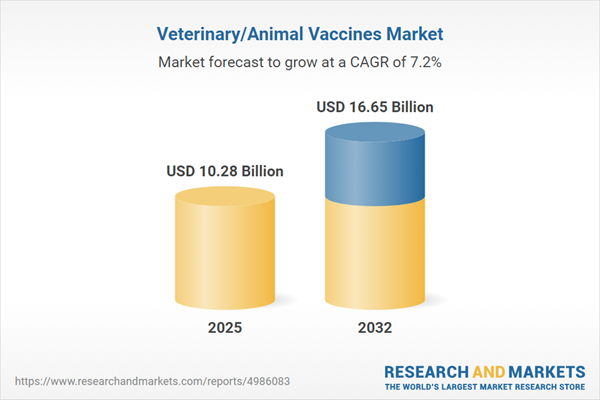Speak directly to the analyst to clarify any post sales queries you may have.
The veterinary/animal vaccines market is undergoing fundamental change, marked by evolving regulatory and technological standards. Leadership teams are being called to proactively manage organizational resilience and uphold animal health outcomes as competition grows and compliance demands intensify.
Market Snapshot: Veterinary/Animal Vaccines Market Overview
In 2024, the global veterinary/animal vaccines market has reached a value of USD 9.58 billion, with projections advancing to USD 10.28 billion by 2025 and USD 16.65 billion by 2032. This reflects a robust CAGR of 7.15%, underscored by continued progress in biotechnology, a broader commitment to animal health and welfare, and heightened demand for preventive solutions. Industry leaders are recalibrating strategies in response to evolving consumer expectations, complex regulatory environments, and increasing competition across major markets. As innovation accelerates, organizations face the need to continuously evaluate operational models and investment directions to stay ahead in a dynamic landscape shaped by scientific advancement and market expansion.
Scope & Segmentation in the Veterinary/Animal Vaccines Market
This report provides senior decision-makers with actionable intelligence to fine-tune procurement, investment, and compliance strategies. The research dissects the market by essential criteria, each presenting unique considerations for operational efficiency and risk control:
- Animal Types: Covers aquaculture, cattle, companion animals, equine, poultry, and swine. Each group faces specific biosecurity risks, requires tailored regulatory navigation, and involves distinct vaccine supply chain complexities.
- Vaccine Technologies: Includes conjugate, killed/inactivated, live attenuated, recombinant, subunit, and toxoid vaccines. Selection depends on disease profile, application setting, and region, with regulatory factors shaping product adoption.
- Administration Routes: Examines injectable, nasal, and oral delivery, which influences adoption rates, operational workflows, and success across veterinary and agricultural contexts.
- Disease Types: Addresses bacterial, parasitic, and viral disease categories, prompting organizations to develop layered prevention and focused R&D priorities.
- End Users: Outlines veterinary clinics, animal hospitals, and commercial farms with varying purchasing patterns, workflow expectations, and implementation requirements critical for effective vaccination programs.
- Regions Covered: Reviews dynamics in the Americas, Europe, Asia-Pacific, and Middle East & Africa. Regional differences in regulatory posture, market development, and growth momentum shape procurement and go-to-market strategies in each area.
- Notable Companies Analyzed: Profiles Boehringer Ingelheim GmbH, Merck Animal Health, and Zoetis Inc., focusing on their roles in innovation and compliance at local and global levels.
Key Takeaways: Strategic Insights for Senior Decision-Makers
- The adoption of new-generation vaccines elevates disease prevention effectiveness, enhances compliance, and supports adaptation to shifting standards across segments.
- The integration of digital animal health monitoring and diagnostic tools allows for timely insights, quicker responses, and proactive management across production and medical environments.
- Applying analytics supports organizations in risk anticipation and resource optimization, empowering leaders to act on emerging animal health challenges with greater precision.
- Improving supply chain resilience and optimizing cold chain logistics are essential for maintaining consistent vaccine access under evolving market or regulatory pressures.
- Cross-functional collaboration between veterinary professionals and support staff underpins smooth vaccine implementation and the adoption of best practices, driving more consistent animal health outcomes.
- Ongoing compliance auditing and transparent reporting enhance trust among stakeholders, ensuring continued alignment with international and regional regulatory frameworks.
Tariff Impact: Strategic Consequences for the Animal Vaccine Supply Chain
With tariffs anticipated for 2025, organizations must prepare for increased volatility in the animal vaccine supply chain. Both producers and buyers are increasing sourcing diversity and prioritizing local procurement to mitigate potential disruptions in core input availability. Stronger regulatory collaboration remains central to minimizing impact, securing reliable access to vaccines, and quickly addressing new market challenges.
Methodology & Data Sources
This analysis draws from direct interviews with industry leaders, targeted field observations, and comprehensive reviews of regulatory and technical literature. Scenario-based modeling and expert panel input contribute to actionable, current intelligence aligned with real-world market evolution.
Why This Report Matters
- Enables executives to update procurement, investment, and compliance practices in step with regulatory shifts and technological progress.
- Explains how integrating process innovation and advancing technologies can improve risk controls and agility across multiple geographical regions.
- Offers a practical framework for aligning business objectives with emerging market pressures and increasing compliance requirements.
Conclusion
The future of the veterinary/animal vaccines sector depends on continuous innovation, agile compliance leadership, and data-driven strategy. Informed decision-making positions organizations to safeguard animal health and secure lasting operational resilience.
Additional Product Information:
- Purchase of this report includes 1 year online access with quarterly updates.
- This report can be updated on request. Please contact our Customer Experience team using the Ask a Question widget on our website.
Table of Contents
3. Executive Summary
4. Market Overview
7. Cumulative Impact of Artificial Intelligence 2025
Companies Mentioned
The companies profiled in this Veterinary/Animal Vaccines market report include:- Boehringer Ingelheim GmbH
- Merck Animal Health
- Zoetis Inc.
- Hester Biosciences Limited
- Indian Immunologicals Ltd.
- Elanco Animal Health Incorporated
- Ceva Santé Animale
- Phibro Animal Health Corporation
- Huvepharma
- Arko Laboratories
- Anicon Labor GmbH
- Kemin Industries
- Hipra
- Vaxxinova
- Pfizer, Inc.
- Dechra Pharmaceuticals Limited
- Bimeda Biologicals Inc
- Neogen Corporation
Table Information
| Report Attribute | Details |
|---|---|
| No. of Pages | 184 |
| Published | November 2025 |
| Forecast Period | 2025 - 2032 |
| Estimated Market Value ( USD | $ 10.28 Billion |
| Forecasted Market Value ( USD | $ 16.65 Billion |
| Compound Annual Growth Rate | 7.1% |
| Regions Covered | Global |
| No. of Companies Mentioned | 19 |









